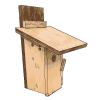Nest Boxes
Bluebird Nest Boxes are made with many features in mind. Hole size, nest area size and location are just a few features to keep in mind when designing a Bluebird Nest Box.
The NABS Nestbox Recommendations Factsheet covers many of these features in detail.
Guidelines for Nest Box Construction
Whether you buy it or make a bluebird nest box, be sure that it fits these criteria.
- No perch should be attached to the front of the box, for this may encourage house sparrows, which are undesirable competition.
- Entrance holes should be 1 ½ inches in diameter for eastern bluebirds and 1 ⅝ inches for mountain and western bluebirds. If the hole is oval it should be 1 ⅜ inches wide and 2 ¼ inches long.
- Floor dimensions should be approximately 4 by 5 inches for eastern bluebirds and 5 by 5 inches for mountain and western bluebirds.
- Height of the top of the floor to the bottom of the entrance hole should be 5-7 inches.
- Opening the box should be easy for monitoring and cleaning. Side or front opening boxes are easiest to clean, however top opening boxes are easiest to monitor.
- Ventilation by means of small holes drilled at the top of the sides or back, or gaps left between the roof and the sides or front should be provided.
- Drainage holes, such as holes drilled in the floor or the corner tip cut off the floor.
- Attaching the box to a tree or post should be easy and provided for.
- Insulate from the sun by using at least ¾ inch thick wood.
- The roof should overhang the entrance by at least 1-2 inches to keep out the rain and shade the entrance.
- Provide a ladder for the birds. Make a series of saw cuts on the inside below the entrance. A hole-saw on a drill press is the safest method.
Wood is still probably the best and safest material with which to make the Bluebird nest boxes. This is because wood mimics natural nest cavities, is relatively inexpensive, is easy to work with and provides good insulation. Pine, cedar and exterior plywood are all good choices.
Wood preservatives are another issue. It is generally agreed that pressure treated lumber should not be used, because the chemicals in it are toxic. Finishes and stains should be applied only to the outside of the box and should not be too dark, since dark colors absorb more heat and will make the box hotter. Linseed oil is a safe preservative. However be sure it is thoroughly dry before setting the box out.
Some nests can overheat in the summer. Birdhouses that sit out in the summer develop inside temperatures higher than those of the air outside the house. In some nest boxes, the internal temperature can be as much as 22 °F higher than the outside air temperature. Any box reaching 107 °F can harm the birds.
Nest Box Plans
You may also look through the ready-made plans here and download the plans you would like:




The Entrance Under and the Easy View Open nest boxes use old nails used as pins to secure the view and cleanout doors. No tools!
The Easy View Clean nest box has a roof that comes off for viewing. And the front is a door that swings out for cleaning.
The Entrance Under nest box uses the concept that Bluebirds will and can use the entrance hole on the bottom. It is also thought the Tree Swallow will not use an entrance hole like this one leaveing it to the Bluebirds. Another nice thing about this nest box is that if the theories are wrong and the Bluebird rejects it, an entrance hole could be drilled in the front board making it usuable again.
The tin flashing is an unproven idea that hopefully will work.
If anyone uses these nest box plans please let me know how they worked for you.
The Easy View was a collaberated effort of Jim Potter and Clarke Snell. The Entrance Under nest box was designed by Clarke Snell using the concept (not his) of the hole in the bottom.
